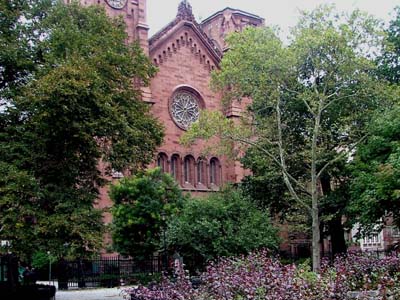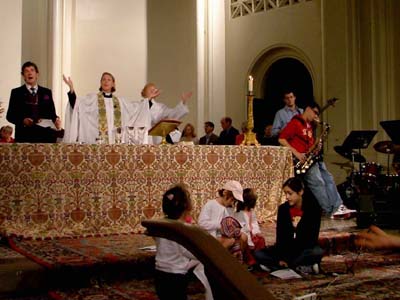 |
||||||||||
 |
||||||||||
|
1169: St George's, Stuyvesant Square, Manhattan, New York, USA  Mystery Worshipper: Amanda B. Reckondwythe. The church: St George's, Stuyvesant Square, New York, USA. Denomination: Episcopal Church in the USA. The building: This large Romanesque Revival church sits on Stuyvesant Square at East 16th Street. The building was completed in 1856, although the parish itself dates back to 1749. The interior is tall and wide, with dark wood pews and ceiling ribbing and light beige walls. The sanctuary is remarkable for its lack of decoration save for a large wooden cross above the altar. The altar is wide and reminded me of the table Da Vinci depicted in his famous rendering of the Last Supper. Choir stalls rise step-like from either side of the sanctuary; over these sit the organ pipes. The church: The financier and philanthropist JP Morgan was a warden and faithful communicant of St George's. Harry T. Burleigh, the noted arranger of African-American spirituals and friend of the composer Antonin Dvorak, served in the choir from 1894 until 1946, a span of 52 years. Along with Dvorak, he helped the spiritual gain its rightful place in musical annals. In 1975 St George's merged with nearby Calvary and Holy Communion parishes, and the resulting entity is officially known as Calvary St George's. Calvary Church remains open to this day, but the Church of the Holy Communion was closed soon after the merger. The neighborhood: Stuyvesant Square, just west of that stretch of Second Avenue known as Bedpan Alley because of the several hospitals located there, is one of the most handsome and historic neighborhoods in Manhattan. It was named for Peter Stuyvesant, the last governor of the Dutch colony of New Netherlands. Once the site of the homes of New York's weathiest citizens, the area still abounds with elegant brownstones. Antonin Dvorak lived on East 17th Street, just around the corner from St George's. The green, leafy Stuyvesant Park shields the area from the hustle and bustle of Second Avenue. Stuyvesant Square's unique charm and architectural distinction have been protected since 1975 by its designation as an official historic district. The cast: The Rev. Nancy W. Hanna, associate rector, was the celebrant. The preacher was Mr Nigel Goodwin, a visitor from the Isle of Wight, where he is executive director of Genesis Arts Trust, a ministry dedicated to the spiritual needs of Christian artists. The date & time: October 9, 2005, 11.00am. What was the name of the service? Family Eucharist, 21st Sunday after Pentecost and commemoration of St Francis of Assisi. How full was the building? About 100 people and two dozen pets, mostly dogs. The building can probably hold around 700. Did anyone welcome you personally? A gentleman handed me a service leaflet and wished me good morning. A praise band was rehearsing, and I asked him if they would be playing the entire service. He replied that they play before the call to worship and again at communion, but othewise the service is a traditional one (he was mistaken, as will be seen). Was your pew comfortable? No. The back was just the right height to dig into the spine most uncomfortably. The kneelers were the individual hassock type, which I always find uncomfortable. Fortunately we didn't kneel at any point in the service. How would you describe the pre-service atmosphere? It being St Francis Day, the congregation had been invited to bring their pets to church with them. People and dogs alike were getting to know one another. What were the exact opening words of the service? "Good morning. Welcome to St George's. It's a rainy day but we're so pleased to have you worship with us." What books did the congregation use during the service? 1982 Hymnal, service leaflet. The Prayer Book was not used, as the service leaflet contained a very thorough order of service. The Holy Bible, New Revised Standard Version, was available in the pews. What musical instruments were played? Pipe organ for two of the hymns, but most of the music was provided by a praise band consisting of piano, electric guitar, double bass, saxophone, tambourine and drums, plus three vocalists. Did anything distract you? The service did not hold my attention, and so I found lots of things to distract me – the sparse decor, the rag-tag appearance of the praise band, the attention the animals were paying to each other, the unorthodox informality of the liturgy, etc. Was the worship stiff-upper-lip, happy clappy, or what? It was just about as happy-clappy as you can get in an Episcopal church. The praise band started things off with some numbers that had people waving their arms and dancing in the aisles. During the St Francis Day blessing of the animals, which took place right after the exchange of peace, the praise band broke into a spontaneous rendition of the Battle Hymn of the Republic, which the preacher had mentioned during his sermon, and this resulted in more arm waving and dancing in the aisles. Communion was in the round – everyone gathered round the altar for the eucharistic prayer, and the celebrant danced a little liturgical jig at the sanctus. Just about the only thing we didn't do was hold hands at the Lord's Prayer.  Exactly how long was the sermon? 30 minutes. On a scale of 1-10, how good was the preacher? 7 – Nigel Goodwin's style was very dramatic, with much arm waving, shouting, whispering and use of slang. He even did a little dance in the pulpit at one point. The animals became rather excited at some of his volume swings. He said that he was a night person and to preach at 11.00 in the morning was something of an effort. He had dined late the previous evening and recalled that Jesus had done so much over food. He wondered if Jesus wouldn't feel more at home in a pub than in a stuffy church. In a nutshell, what was the sermon about? Mr Goodwin spoke on the meaning of glory. He began by quoting the Gerard Manley Hopkins poem "Pied Beauty" ("Glory be to God for dappled things") and also called our attention to John 1. The heavens are full of God's glory – and we have seen it! Glory cannot be contained – after all, God created color. Are we drab grey or are we glorious pink? If you know Jesus, you know glory. Jesus took the ordinary and made it glorious. He changed water into wine; he took mud made from dust and spittle and gave sight to a blind man; he wiped his disciples' feet with an ordinary cloth towel. And finally he took a cross and died on it, so that the mystery of God's glory might be revealed. Which part of the service was like being in heaven? My concentration wandered during most of the service, but when the preacher began to talk about how Jesus made the ordinary glorious, culminating in taking a cross and dying on it, my mind snapped to attention. And during one of the hymns, "All things bright and beautiful," a young man in front of me put his arm around his girlfriend and the two of them swayed to the music. I knew he was thinking that God had made his friend bright and beautiful. And which part was like being in... er... the other place? I have to confess that when I first walked in and saw the praise band rehearsing, I made up my mind not to like the service. But as things unfolded, I began more and more to like it in spite of myself. And so I chide myself for allowing such a hellish thought to prejudice my worship. What happened when you hung around after the service looking lost? After communion in the round, and the blessing and dismissal, everyone sort of broke up and wandered off. An announcement had been made that lunch was being provided, and so I followed the path that the majority were taking, thinking that they must be headed for lunch (I was wrong). How would you describe the after-service coffee? The majority, as it turned out, were headed for a room where an artists' group was meeting. The artists had provided coffee for themselves (average, not exceptional, and in plastic cups) along with an assortment of cookies. After some snooping around, I found where lunch was being served. Lunch consisted of sandwiches and chips, but no beverages. I helped myself to a ham, cheese and apple sandwich on thick crusty bread. The young man who had been singing with his arm around his girlfriend engaged me in conversation, but soon a group of his young friends joined him and that was the end of his interest in old Miss Amanda. I then sat next to a woman more my age, and we chatted a bit about the liturgical style at St George's compared to other churches in the area. How would you feel about making this church your regular (where 10 = ecstatic, 0 = terminal)? 4 – Despite my being drawn into the service willy-nilly, it's really not for me. It was far too informal and happy-clappy. I prefer a more traditional, sedate Episcopalian liturgy. Did the service make you feel glad to be a Christian? Yes. The sermon especially gave me much to ponder. What one thing will you remember about all this in seven days' time? Dancing in the aisles in an Episcopal church! |
|
|
||||||||||||||||||||||||||||||||||||
| More Mystery Worshipper reports | |||||||||||||||||||||||||||||||||||||||
 |
|||||||||||||||||||||||||||||||||||||||






